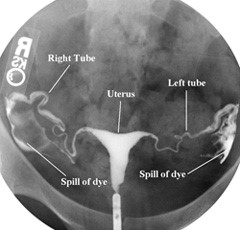
Evaluation
The different types of infertility testing

Infertility poses many challenges. It can affect your relationships and emotional health. Infertility treatments can also be costly and strain your finances. There are a number of tests to determine the cause of infertility. At Shivya IVF any evaluation for infertility will be done in a focused and cost effective way to find all relevant factors, including the male as well as female partners. We recommend one or more of the following studies.
History: Before the tests are performed, your past health and medical history will be reviewed by our infertility specialist and you and your partner will be asked questions to help identify potential causes for your difficulty in conceiving. A physical examination will be carried out.
Male partner Semen Analysis: Sperm number, shape, ability to move is determined by the microscopic examination of semen. This is the only test that will be needed for most men in the workup of infertility.
Blood test: To check testosterone, thyroid and other hormone levels.
Scrotal ultrasound:
Genetic testing: Genetic abnormalities in couple make it more difficult to become pregnant and more likely that a pregnancy ends as a miscarriage. If there is a suspicion that genetic or chromosomal abnormalities are contributing to infertility, a blood sample from both partners is sent to a laboratory for evaluation. If you or your partner is at risk of passing on a genetic disorder to your child, you may be candidates for preimplantation genetic testing — a procedure that involves IVF. After the eggs are harvested and fertilized, they’re screened for certain genetic problems, although not all genetic problems can be found. Embryos that don’t contain identified problems can be transferred to the uterus.
Transvaginal Ultrasonography: An ultrasound probe placed in the vagina allows the clinician to check the uterus and ovaries for abnormalities such as fibroids and ovarian cysts.
Ovarian Reserve Testing: Refers to a woman’s fertility potential. It mainly depends on the number and quality of eggs in the ovaries. Blood tests are now available to estimate your ovarian reserve. Ovarian reserve testing is more important in women who have a higher risk of reduced ovarian reserve and are as follows;
- Have unexplained infertility
- Have a single ovary
- Have a history of previous ovarian surgery, chemotherapy, or pelvic radiation therapy
- Are over age 35 years
- Have a family history of early menopause
- Poor response to previous ovarian stimulation
Antimüllerian hormone (AMH), FSH: Hormones measurement that reflects your ovaries’ capability for producing eggs. Abnormally high FSH or low AMH levels do not mean that you have no chance of successful conception.
Antral follicle count (AFC): A transvaginal ultrasound is used to determine the number of pre-stimulated follicles in the ovary during the first 3-4 days of the menstrual cycle.
Other Blood Tests: Thyroid-stimulating hormone (TSH) and prolactin levels are useful to identify thyroid disorders and hyperprolactinemia.
Tests to evaluate uterus and tubes
Because open and functional fallopian tubes are necessary to get pregnant without assistance, tests to determine tubal openness (patency) are important.
Hysterosalpingogram (HSG): This is a special X-ray procedure to see if the fallopian tubes are open and if the shape of the uterine cavity is normal. It is typically done after your period stops and before ovulation i.e. 7 to 10 days of your cycle. During an HSG, a special fluid (dye) is injected through your cervix, fills your uterus, and travels into your fallopian tubes. If the fluid spills out the ends of the tubes, they are open. If the fluid does not spill out the ends, then the tubes are likely blocked. It is important to note that tubes might still be open even if no spill is seen. If the HSG shows blocked fallopian tubes, your physician may perform a laparoscopy to assess the degree of tubal damage. This test does not require anaesthesia. If a blockage is present, a laparoscopy and dye test is recommended to assess the degree of tubal damage.

Sonohysterogram (SHG): Pelvic ultrasound performed while sterile fluid is injected through your cervix to outline the uterine cavity and can help identify scar tissue, polyps, and fibroids.
Laparoscopy: Laparoscopy is usually performed under general anesthesia. It is often carried out as same-day, minimally invasive surgical procedure. A thin, flexible tube with a camera at the end is inserted into the abdomen and pelvis through a small incision within or just below your navel, to look at the fallopian tubes, uterus, and ovaries. This can reveal abnormalities of the uterus and fallopian tubes. A dye may also be introduced in order to check that there are no blockages in the tubes.
Hysteroscopy: Hysteroscopy, a minor and minimally invasive, often carried out as a same-day surgical procedure. This test may be carried out under a general anesthetic or using a local anesthetic and mild sedation. In this test a thin, flexible tube with a camera at the end is inserted (hysteroscope ) into the uterus via the cervix to examine the inside of the uterus to diagnose and treat problems within the uterine cavity.
Unexplained Infertility
In approximately 10% of couples trying to get pregnant, all of the above tests are normal and there is no easily identifiable cause for infertility. In these cases, the infertility is referred to as “unexplained” and IVF has been shown to be the most effective treatment in such couples. IVF can throw light on problems with egg quality, fertilization, genetics, tubal function, or sperm function that are difficult to diagnose and/or treat.
Summary
We individualize fertility evaluation based on each woman’s specific circumstances in order to get best results. Sometimes the factors affecting your fertility are easy to detect and treat, but in many cases a specific reason for infertility may be difficult to identify and hence only after a full evaluation, we can give you a reasonable idea of your chances of achieving pregnancy with various treatment options. Since your initial treatment may provide additional answers as to the cause of your infertility we continually re-evaluate your plan by discussing treatment results.
